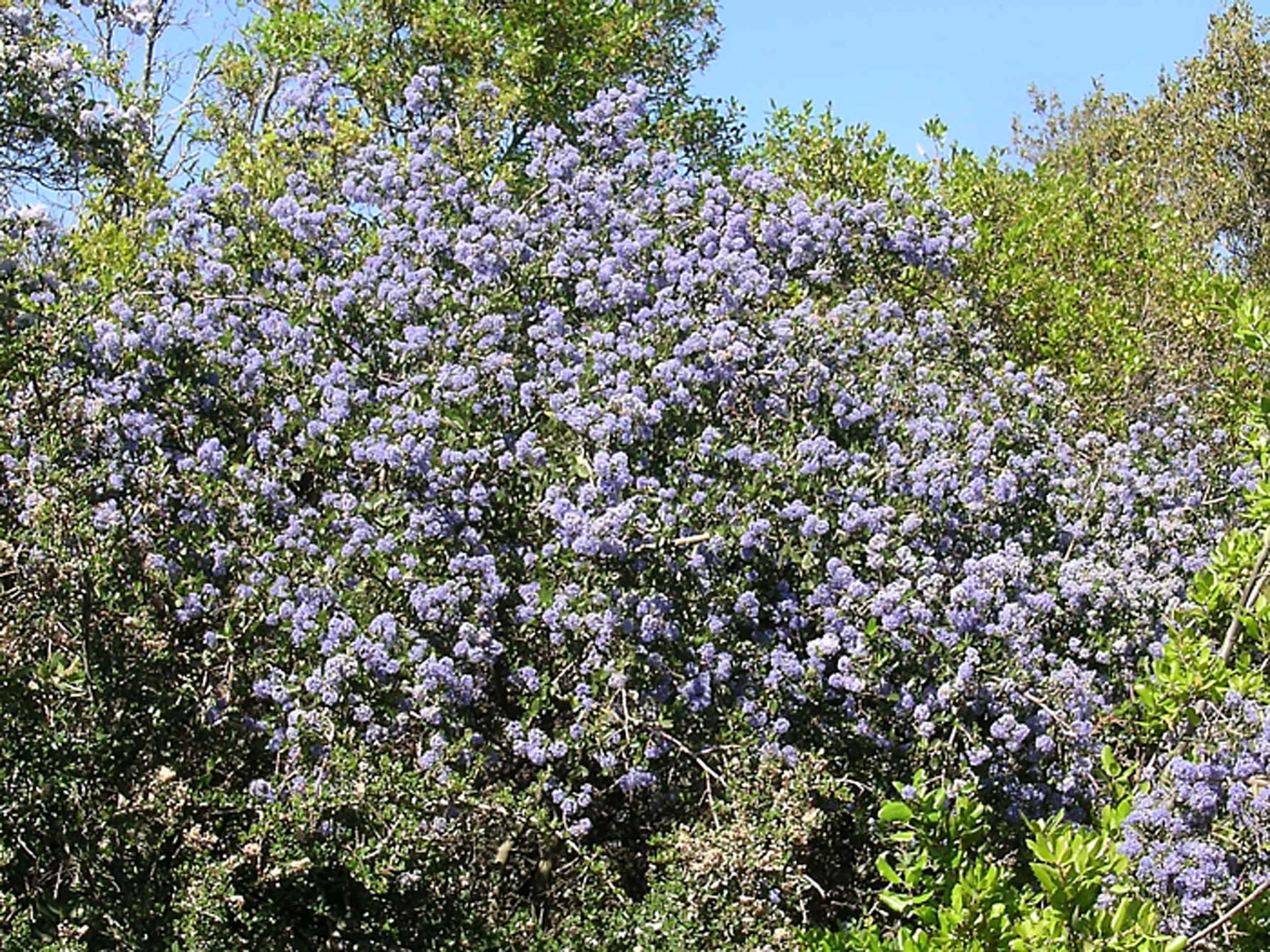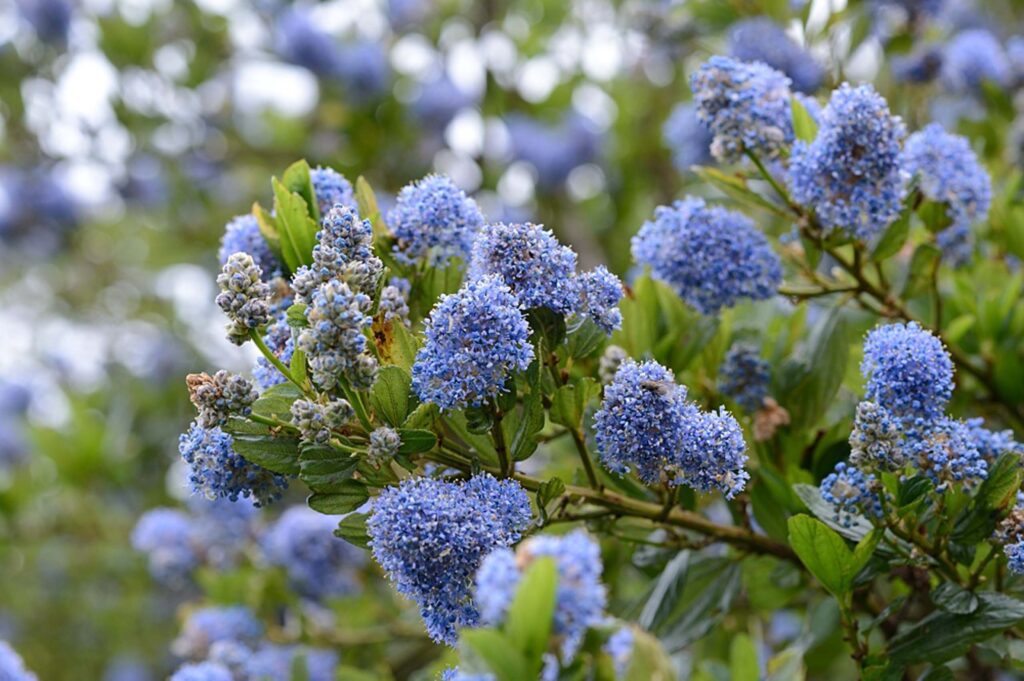
That is the question!
Perhaps you can find the answer to your particular gardening situation in the comparison below. Both species will be available at our Spring 2023 Native Plant Sale.
Julia Phelps ceanothus (Ceanothus ‘Julia Phelps’)
This evergreen hybrid makes a wonderful specimen plant for a California native plant garden, as it provides year-round interest. Also known as small-leaf mountain lilac, the small leaves (half an inch to one inch long) are dark green and crinkly. In late winter to early spring, Julia Phelps ceanothus produces clusters of dark blue flowers that appear to be a deeper blue than blue-blossom ceanothus (Ceanothus thyrsiflorus). Depending on growing conditions, Julia Phelps ceanothus can grow 4 to 8 feet high and up to 12 feet wide, in a fountain or dome shape. This hybrid is cold tolerant to 12 °F, as well as drought tolerant in our hotter climate. While it prefers some spring rains, it can be long-lived, despite drought years. In a drought year with little winter rains, it will do better with a few deep waterings in winter and spring. It can be grown as a small specimen tree, shrub, or hedge. It is tolerant of sand and clay soils, yet has a preference for acidic, sandy, well-drained soils along the coast. Julia Phelps ceanothus may scent the air after rains or on hot days. [Note: we were unable to procure photos of this gorgeous cultivar; however, if you’ll go to California Flora Nursery, you can see four stunning images of this plant.]
Blue-blossom ceanothus (Ceanothus thyrsiflorus)
Blue-blossom ceanothus may grow higher or lower in an upright or mounding form at a moderate to fast rate. In our area, it tends to be a moderately fast-growing, dense evergreen shrub or small tree up to 18 feet tall and wide. Blue-blossom ceanothus produces puffier flower clusters than Julia Phelps ceanothus, from spring to early summer. These flower clusters more typically are a lighter blue than Julia Phelps ceanothus flowers, although they can include white, dark blue, or purple flowers. Its smoother and larger shiny leaves vary from bright to dark green, which makes it easier to see the three main veins that are helpful in identifying ceanothuses. In our hotter Redding area, blue-blossom ceanothus will prefer some afternoon shade, and deep waterings in winter and spring during drought years. This species is cold tolerant to 15 °F and can be frost tender. It tolerates poor soil conditions with good drainage. A light honey-like fragrance may scent the air after rains or on hot days. It is an important food source for 14 confirmed pollinators including birds, butterflies, and bees (another 66 species are likely also pollinators).

Establishing ceanothus
Ceanothus may take several years to become established, especially during drought years. They prefer deep waterings in winter and spring in well-draining soils. They will need more waterings while they are small and not yet established. They dislike drip irrigation and fertilizer.
What is really going on when plants are becoming established: Like most California native plants, in order to thrive in harsher soils, ceanothus need to increase their root mass. They do this over two to three years by forming mycorrhizae. These are “fungus roots” that are much finer than ceanothus roots and represent a symbiotic relationship between ceanothus roots and fungi. This symbiosis increases the surface area of the roots, allowing ceanothus to utilize more soil nutrients, enabling the plant to withstand harsher weather conditions. The relationship takes time to form and may take another year if one of the first growing years is a drought year.
Maintenance for ceanothus in general
Watering: Ceanothus in general prefer deep winter and spring waterings. They do not like drip irrigation. Drip irrigation is believed to shorten their life span, as it saturates the soil around the plant. In our hotter climate, it may be better to deep water once or twice a month in summer and allow the soil to dry out in between waterings.
Pruning: Plant with plenty of room to avoid needing to prune when full-grown; prune lightly for size. Prune after flowering as the flowers grow on the tips of the branches.
Fertilizing: None.
Deer resistance
Ceanothus planted in drier soils may be more deer resistant than those planted in moister soils or watered too much.
Recommended books
Growing California Native Plants, Second Edition. 2012. Marjorie G. Schmidt and Katherine Greenberg; University of California Press.
Native Treasures: Gardening with the Plants of California. 2006. M. Nevin Smith; University of California Press.
The California Native Landscape. 2013. Greg Rubin and Lucy Warren; Timber Press.
~Susan Gallaugher
